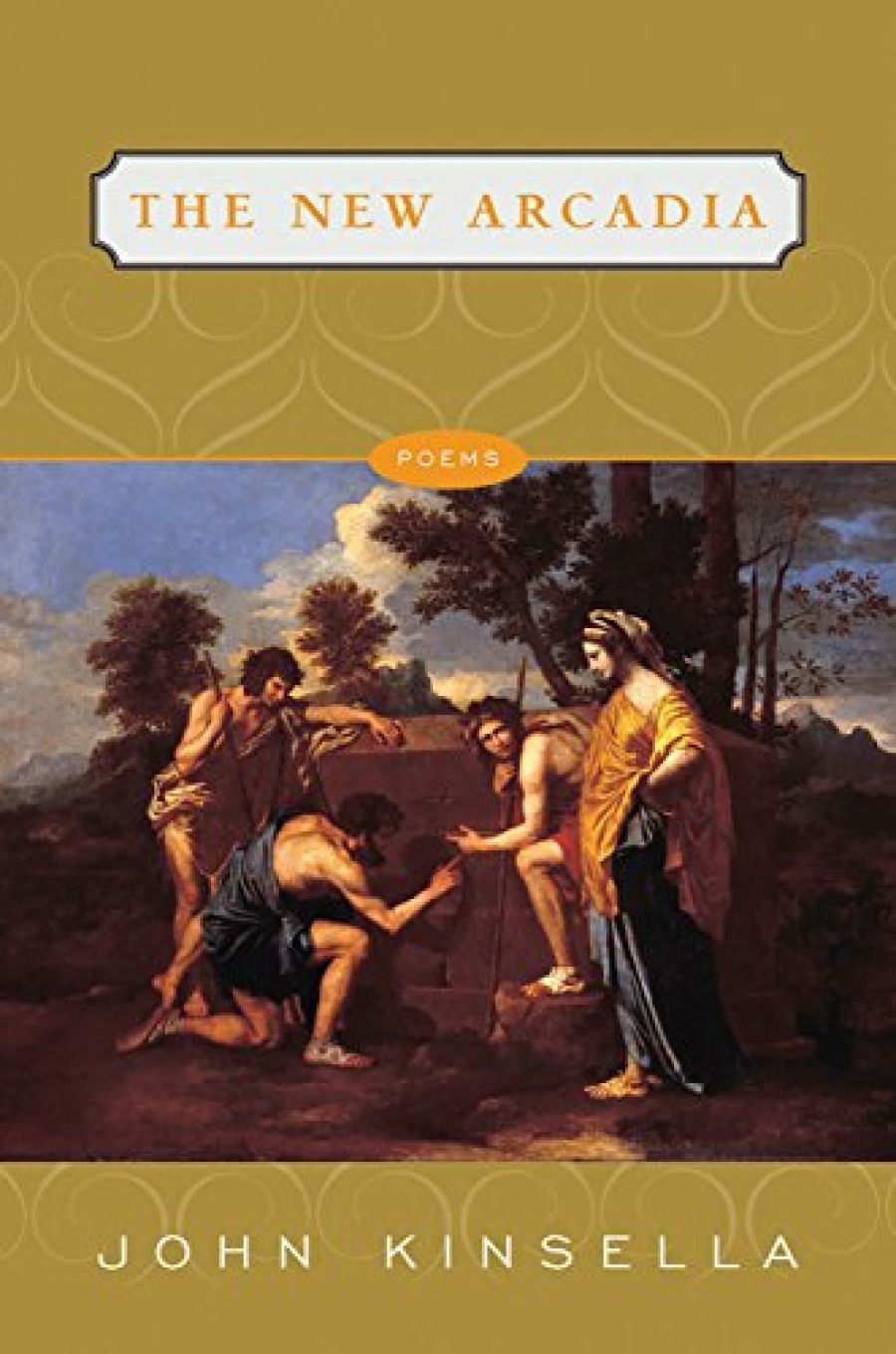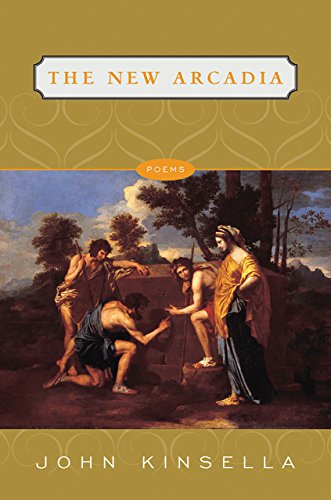
- Free Article: No
- Contents Category: Poetry
- Review Article: Yes
- Article Title: Pastoral crisis
- Online Only: No
- Custom Highlight Text:
In the opening poem of Virgil’s Eclogues, a shepherd newly dispossessed of his farm by a soldier returning from war exclaims: ‘There’s so much trouble everywhere these days. / I was trying to drive my goats along the path / And one of them I could hardly get to follow; Just now, among the hazels, she went into labor …’ (trans. David Ferry). More than 600 years later, Poussin’s painting, Les Bergers d’Arcadie, dit aussi Et in Arcadia Ego (1638–40), takes up the theme of dispossession in a more radical key: even shepherds in Arcadia must die. The pastoral mode (taken broadly to include anti- and post-pastoral) has always enveloped threats to the pastoral idyll. John Kinsella’s The New Arcadia – with Poussin’s painting on its cover – is the final instalment of an ‘anti-pastoral’ trilogy initiated by The Silo: A Pastoral Symphony (1995) and followed by The Hunt (1998). In The New Arcadia, as in its prequels, we find the pastoral mode in full-blown crisis: in modern Australia, nature’s small misfires (viz. the goat’s ill-timed birth) have escalated into ecological disaster. In The Hunt, the farmers and their families are killed by their own tools, dying in accidents, falling under tractors, shooting themselves; in The New Arcadia, on the other hand, most of the victims are native birds.
- Book 1 Title: The New Arcadia
- Book 1 Biblio: FACP, $22.95 pb, 201 pp
- Book 1 Cover Small (400 x 600):

- Book 1 Cover (800 x 1200):

These are poems that are often uncomfortable to read. That is not a criticism, though some of the less ‘positive’ discomfort comes from their tendency to invective. The tone of the poems can be hard-bitten, rebarbative; the keynote is irony. The syntax is frequently elliptic, discontinuous, inverted, starting out from the endpoint of an observation and working back to its subject. As with the American poet Carl Phillips – with whom Kinsella also has in common a fascination with pastoral and a disregard for gender as limit – the difficulty of Kinsella’s syntax typically comes from the attempt to convey the perceiving, thinking mind mid-flight, the synaptic sparks in their moments of light: sparks in which the mind is fused, for an instant, with its world. In certain poems, the perceptions seem to exist almost without a human subject. Technology (as if cut adrift from its makers) and nature interact alone on the stage of the poem:
Machinery works furrows of sound
as the light is barely enough to sustain,
furtive flowers lately opening,
brief in the spectrum leap
between yellow and blue,
a colour that sounds as both
merged true, its collusion science
or elicitation, the motor’s torque
as the crankshaft drives heavy rubber(‘Dusk and the Body Politic’)
This poem, incidentally, is an excellent illustration of a perspective – or anti-perspective – that is native to Kinsella’s poetics: a vision of simultaneity, inclusiveness, a cataloguing, gathering, memorising vision of an (often painful) interconnectedness. Kinsella possesses a ‘moving cinema-like eye that homes in on a detail, then springs back to survey a panorama’ – a description of Walt Whitman’s poetics, but no less valid here. This anti-perspective is present in most of the long ‘Reflectors: Drive’ poems that open each of the five ‘Acts’ – a structure derived from Sir Philip Sidney’s The Countess of Pembroke’s Arcadia (as well as its use of eclogues). These ‘roadtrip’ poems are set along the road home to Kinsella’s family property in Western Australia. Each drive sparks a torrent of associations, channelled only by relatedness to the road, in which the past is as vivid as the present, and nature and local cultures are locked in ongoing strife. In ‘Drive 4’, one of the more personal (and, rarely, vulnerable) poems in the collection, it is the poet’s partner who is driving, the poem ‘[timed] with [her] return’: ‘at so many metres and so many words / per minute, per hour. Tracking / you with text, and your being conscious / of it …’ Then come the flashes of shattered perspective, whose brilliance is tempered only by the way in which the choppy shorthand of the phrases produces, at times, a monotonous effect prosodically:
… The heater not working,
cold forcing a hand under a leg,
one hand on the wheel. Sheep on a ridge.
Variegated colours of soil exposed
with drought. Scarrings of frost.
As a poet, Kinsella is acutely attuned to the dramatic. Eclogues, having the structure of dialogues, should be an excellent vehicle for such a poet. But what are we to make of the fact that each ‘dialogue’ divides rather stiffly into parallel monologues? Kinsella shows his awareness of this in subtitling the first eclogue of the book, ‘The Brothers’, ‘A Monologic Eclogue’. I found myself wondering whether the un-dialogic character of these dialogues reflects Kinsella’s actual pessimism about conflict resolution through communication, or whether we’re being led into a kind of temporary cul-de-sac of poetic vision. Is invective really a poetic end in itself? Can it ever be a means to force a breach in prejudice, a change of attitude, a wider conversation? Is there ‘a poetry of abuse’ – the subtitle of one poem (another is titled ‘The Shitheads of Spray’)? Robert Frost wrote that a poet’s ‘style is the way he carries himself toward his ideas’. A degree of separation between the ideas and the poet is implied, the degree being greatest when the poet is least under pressure: ‘[t]he style is out of his superfluity.’ Invective allows no separation. For this reader, the most convincing of the eclogues, ‘Vigilante Eclogue’, is one in which two perspectives converge on the same events, never meeting still, yet on the side of the victim, at least, approaching conciliation: ‘In some ways, I believe as my neighbours / believe, differently.’ Here is openness, even compassion, against steep odds. There is style in this response.


Comments powered by CComment